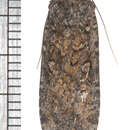en
names in breadcrumbs


Euxoa is a genus of moths of the family Noctuidae raised to Genus by the German entomologist, Jacob Hübner. The Genus is mostly confined to dry and semi dry areas in the Northern Hemisphere. There 130 species in Eurasia, a few in Africa, and 175 in North America. There are no species in the Genus in South-East Asia or in Australia.[1] In North America, most species are found in Western regions. Of the North American species, 4 are endemic to Mexico. There is one species recorded from Chile, but this may be a mislabeled specimen.[2] In real terms, species numbers do not equal species abundance. Some areas with few species have large numbers of the ones that do live there.
In North America there are 7 subgenera - Chorizagrotis, Palaeoeuxoa, Heteroeuxoa,Longivesica, Pleuonectopoda, Orstagrotis, and Euxoa.
The larvae of this Genus are Cutworms, living in the soil but feeding on the surface. A few species also climb. Most larval Euxoa hatch from eggs laid in autumn, and most go though a summer diapause, before pupating when the temperature drops later in the summer.[3] The Genus includes the prolific miller moths, which are full adult army cutworms labeled as the species Euxoa auxiliaris and common in North America.
Euxoa is a genus of moths of the family Noctuidae raised to Genus by the German entomologist, Jacob Hübner. The Genus is mostly confined to dry and semi dry areas in the Northern Hemisphere. There 130 species in Eurasia, a few in Africa, and 175 in North America. There are no species in the Genus in South-East Asia or in Australia. In North America, most species are found in Western regions. Of the North American species, 4 are endemic to Mexico. There is one species recorded from Chile, but this may be a mislabeled specimen. In real terms, species numbers do not equal species abundance. Some areas with few species have large numbers of the ones that do live there.
In North America there are 7 subgenera - Chorizagrotis, Palaeoeuxoa, Heteroeuxoa,Longivesica, Pleuonectopoda, Orstagrotis, and Euxoa.
The larvae of this Genus are Cutworms, living in the soil but feeding on the surface. A few species also climb. Most larval Euxoa hatch from eggs laid in autumn, and most go though a summer diapause, before pupating when the temperature drops later in the summer. The Genus includes the prolific miller moths, which are full adult army cutworms labeled as the species Euxoa auxiliaris and common in North America.